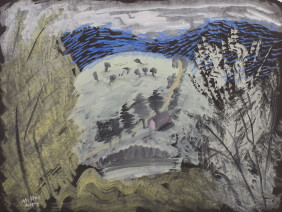
Milton Avery
Pale Fields, c. mid-late 1930s
Oil on canvas
66 x 83.8 cm
26 x 33 in
26 x 33 in
It is a fine and natural blend he has though not easily defined. He is a poet, a colorist and a decorator; so excellent in each of these divisions that he might exist on any one of them, yet I presume being a poet will be his strongest claim. He has been doing landscape . . . in Vermont . . . He doesn’t really do the landscape, but, as we now say, the ‘emotion’ that he had when viewing it. These emotions must be akin to those of a musician, for he becomes, in his best… distinctly lyrical. Henry McBride Archives of American Art N68/95 quoted in Lit #194
Pale Fields is one of a pair of related works, the other being the gouache on paper Musical Landscape. In the catalogue to the exhibition Milton Avery’s Vermont Jamie Franklin writes about the pairing: “Pale Fields is one of Avery’s lightest Vermont oils, both coloristically and in terms of paint handling. Yet it was, somewhat ironically, developed from a gouache executed on black construction paper, Musical Landscape, which makes effect use of the dark ground, especially for the mountain looming in the background. I find myself particularly drawn to a passage in the lower left of both works. In the gouache, the topmost of three wide horizontal strokes of yellow at bottom center, executed with what seems to be an unconscious quiver of the wrist, is positioned to the right of an oddly shaped area of reserved black paper, effortlessly evoking a small group of unruly bushes. The artist seems to have enjoyed the associative effectiveness of this seemingly spontaneous passage and took great pains to transcribe it in the final oil.”
The painting is one of a number of key works that reveal a lightening of Avery’s palette during the mid to late 1930s.
Franklin goes on to note that: “The dense, often heavily worked, earthy palette in Avery’s earliest Vermont oils from the mid-1930s gives way, gradually and not always in a linear manner, to more delicate, luminous oils in the late 1930s and into the 1940s. This might be attributable to Avery’s practice of creating at least one watercolor most mornings during his summer holidays.”
The Averys spent their first summer in Vermont’s Green Mountain and Finger Lakes area in 1935, and returned there five times between 1936 and 1943. Some summers Mark Rothko and Adolph Gottlieb were there, as well as the art historian Meyer Schapiro and his wife Lillian Milgram—the Averys’ neighbors in Greenwich Village—who had purchased a home in Rawsonville in 1933. The Averys summered in Southern Vermont, in Jamaica or nearby Rawsonville.
Exhibitions
Milton Avery, Victoria Miro Mayfair, London, June 7 - July 29 2017Milton Avery’s Vermont, Bennington Museum, Vermont, USA, 2 July - 6 November 2016
Milton Avery, Victoria Miro, London, 7 June – 29 July, 2017
Literature
Milton Avery, essay by Edith Devaney. London: Victoria Miro, 2017, illustrated, n.p. Wajahat, Waqas.Publications
Franklin, Jamie, Karen Wilkin, et al. Milton Avery’s Vermont, ed. Robert Wolterstorff. Bennington Museum, Bennington, Vermont (2016). Listed page 68; plate 22, page 23; mentioned in the text page 35, 36
Milton Avery, Victoria Miro Mayfair, London (2017). Illustrated
